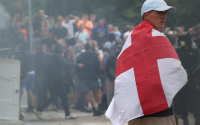Fresh allegations of American abuse of prisoners continue to appal the world. But now 'The Independent on Sunday' has uncovered proof of US troops deliberately and indiscriminately shooting civilians. Here we examine new evidence that suggests the lawlessness in the American military was never confined to the prison camps and torture rooms but extended to the streets and homes of IraqBy Raymond Whitaker in London and Justin Huggler in Baghdad23 May 2004 -- Amid the welter of ugly pictures from Iraq last week were images worse than those of the humiliation and torture of detainees in Abu Ghraib prison. These show chunks of flesh and hanks of women's hair scattered across a scene of devastation. Among the few recognisable objects are musical instruments.This is the scene of an incident that has divided Iraqis from their occupiers like few others. It has highlighted an issue more significant, yet far less discussed, than mistreatment in prisons: the degree to which indiscriminate use of American firepower has made enemies of the Iraqi population. According to independent estimates - none are available from the coalition - about 11,500 Iraqi civilians have been killed since the start of the war in March last year.The footage of flesh, hair and musical instruments was filmed by a video crew that reached the location of what local people say was a wedding party attacked without warning by the Americans, killing women and children. The instruments belonged to the band of Hussein Ali, one of Iraq's most famous wedding singers, whose relatives buried him in Baghdad last week.Despite this evidence - and earlier pictures filmed by al-Arabiya television, showing two dead babies wrapped side by side in a blanket, and a headless child lying next to the body of his or her mother - American commanders continue to insist that their strike, on a remote village in the desert close to the Syrian border, was against foreign fighters crossing into Iraq."These were more than two dozen military-age males," scoffed Maj-Gen James Mattis, commander of the US 1st Marine Division. "Let's not be naive." What about the video footage? Maj-Gen Mattis said he had not seen it, but added: "Bad things happen in wars. I don't have to apologise for the conduct of my men." Although an investigation has been promised, the chairman of the joint chiefs of staff, General Richard Myers, said in Washington: "We feel at this point very confident that this was a legitimate target, probably foreign fighters."Not only that: the Americans are now also dropping hints that the "foreign fighters" could be linked to Abu Musab al-Zarqawi, an Islamist militant leader and ally of Osama bin Laden who is in Iraq, and who is accused of personally beheading the American hostage Nick Berg. Although such a connection was "still to be determined", said General Myers, it was "not out of the question".More telling, however, was the reaction of the occupation authorities to the damaging video footage. US officials demanded al-Arabiya give them the name of the cameraman who shot the pictures. Al-Arabiya refused.As the Abu Ghraib scandal has proved, shocking images can lead to investigations not only in Iraq but in Afghan-istan, Guantanamo Bay and elsewhere, and cause trouble not only for the military but for the CIA and the White House as well. Until they saw the pictures, Americans were unaware of what was happening to Iraqis in custody; they remain ignorant of the reasons for the mounting toll of civilian deaths, both during and since the invasion last year, despite the evidence of those few Americans who have witnessed them, such as Staff Sergeant Jimmy Massey, reported opposite.Ever since the occupation began, there have been regular stories of American soldiers who were attacked by insurgents on the streets of Iraqi cities and reacted by spraying the entire area with wild, indiscriminate gunfire, killing and maiming innocent Iraqi bystanders. Other accounts, however, are even more sinister.Before he was jailed for a year last week for failing to return from leave, another soldier who served in Iraq, Sergeant Camilo Mejia, said a friend of his, a sniper, had shot a child about 10 years old who was carrying an automatic weapon. "He realised it was a kid," said Sergeant Mejia. "The kid tried to get up. He shot him again." The child died.Few images exist of such incidents, not least because journalists seeking to record them have ended up dead themselves. Thanks to the persistence of one or two news organisations that have lost employees in Iraq, these deaths are among the few to have been independently investigated. After an award-winning cameraman, Mazen Dana, became the second Reuters employee to be killed, the agency hired a security company and carried out an exhaustive inquiry which found few differences of fact with the military investigation, but which differed radically on the conclusions.The soldier who shot Mr Dana claimed he had made "sudden movements" which made him think the cameraman was about to fire a rocket-propelled grenade, that he was blinded by the sun at the time, and that he could not distinguish at a distance of 75 metres between an RPG and a television camera.Despite pages of evidence proving the sun was not in the position claimed, and photographs demonstrating the visible difference at 75 metres between a camera and a large weapon, the US military is sticking to its finding that the journalist's death was "justified based on the information available ... at the time".If an organisation with the international clout of Reuters cannot get the Pentagon to admit an error might have been made, the survivors of last week's slaughtered wedding party have even less chance that their version of events will prevail. But the incident illustrates several of the concerns expressed about the operations undertaken by US forces in Iraq, including their ignorance of Iraqi culture, their isolation from local people and their over-dependence on firepower."How many people go to the middle of the desert 10 miles from the Syrian border to hold a wedding?" demanded Maj-Gen Mattis.The answer is plenty, if you come from a clan of livestock herders and that is where you have lived all your life. The clan straddles the Syrian border; even distant relatives would be expected to turn up from there, as well as the far corners of Iraq.Brigadier General Mark Kimmitt, the US military spokesman in Iraq, said US forces found guns, Syrian passports and a satellite phone at the scene of the fighting. None of that was surprising, either: even in the cities, every house has a weapon. In a village 75 miles from the nearest town they are even more necessary, both to protect against bandits and to shield flocks from wild animals. With no telephone lines and no mobile coverage, it is not unusual for such places to have a satellite phone as well."The British military tends to have far more open dealings with the local population than the Americans," said Christopher Bellamy, professor of military science at Cranfield University. "While the British rely more on local intelligence to warn them of trouble in advance, US forces have a 'stand-off' posture, which means trouble tends to erupt without warning. As a result they need to deliver enormous amounts of firepower to overcome it."Eleanor Goldsworthy, UK forces specialist at the Royal United Services Institute, said the approach taken by British forces in Iraq was: "If we behave, we earn their goodwill." The American attitude, by contrast, was: "If they behave, they earn our goodwill." And if they don't, others might add, US forces will punish them - the policy that appeared to be adopted when the Marines moved on Fallujah last month in the wake of the deaths of four American private security men.The insistence of the US Defence Secretary, Donald Rumsfeld, on a "war lite" policy, said Professor Bellamy, meant that "American forces have to make up in firepower what they lack in manpower". Because US soldiers specialised early in their careers, and received less overall training than their British counterparts, the majority were not effective combat troops, and had to be protected by those with the appropriate training."The philosophy is almost that of the wagon train, and tends to lead to the 'spray and slay' behaviour we have seen," said the analyst."It is hard to over-estimate the lack of awareness of most American soldiers in Iraq," said a military source. "Many, perhaps most, have never been abroad before. They see their mission as giving democracy to the Iraqis and enforcing stability, and find it very difficult to understand why the Iraqis aren't grateful. They have no idea that they are seen as arrogant and aggressive."In the view of British forces, the source added, such attitudes had led to a succession of "fundamental mistakes", and had made senior officers extremely hostile to being put under American command. This is one of the options reported to be under consideration by Downing Street this weekend as the deployment of more British forces is weighed.The US wants Britain to take over from the departed Spanish contingent in the Shia holy cities of Najaf and Karbala, where American firepower is being deployed against militias loyal to Muqtada al-Sadr, the Shia cleric declared an outlaw by Washington."Seeking to adopt normal low-profile British tactics in the wake of American aggressiveness would be difficult enough," said the military source, "but to have to go in under US operational command would be a disaster."

Canlı Yayın
-
Canlı Yayın'a Geri Dön





